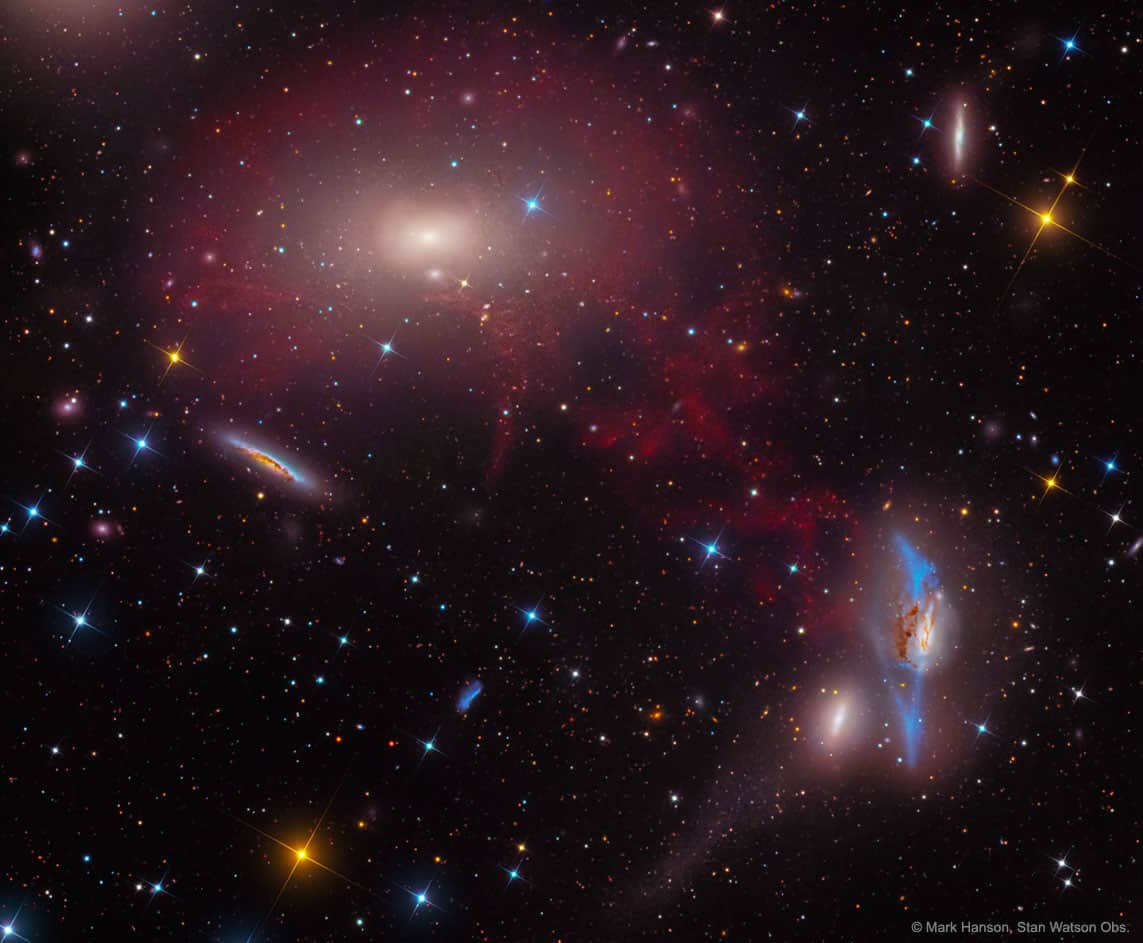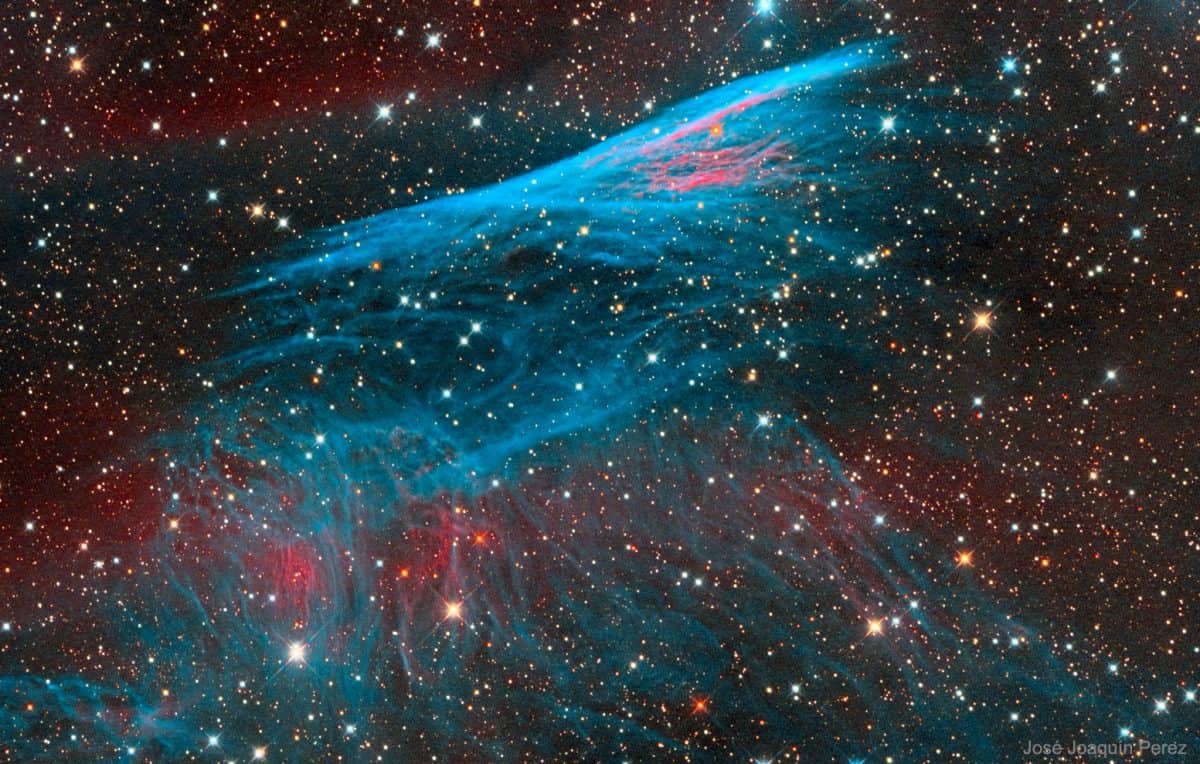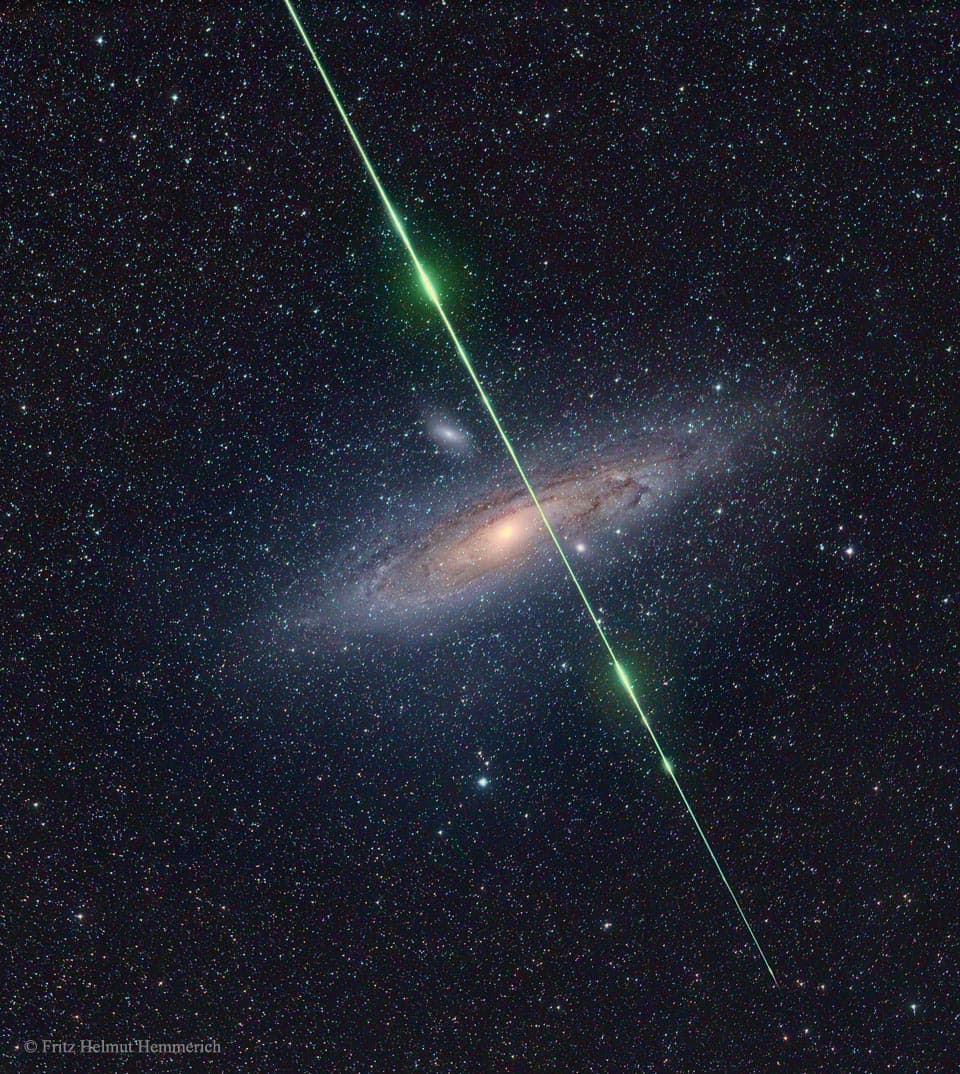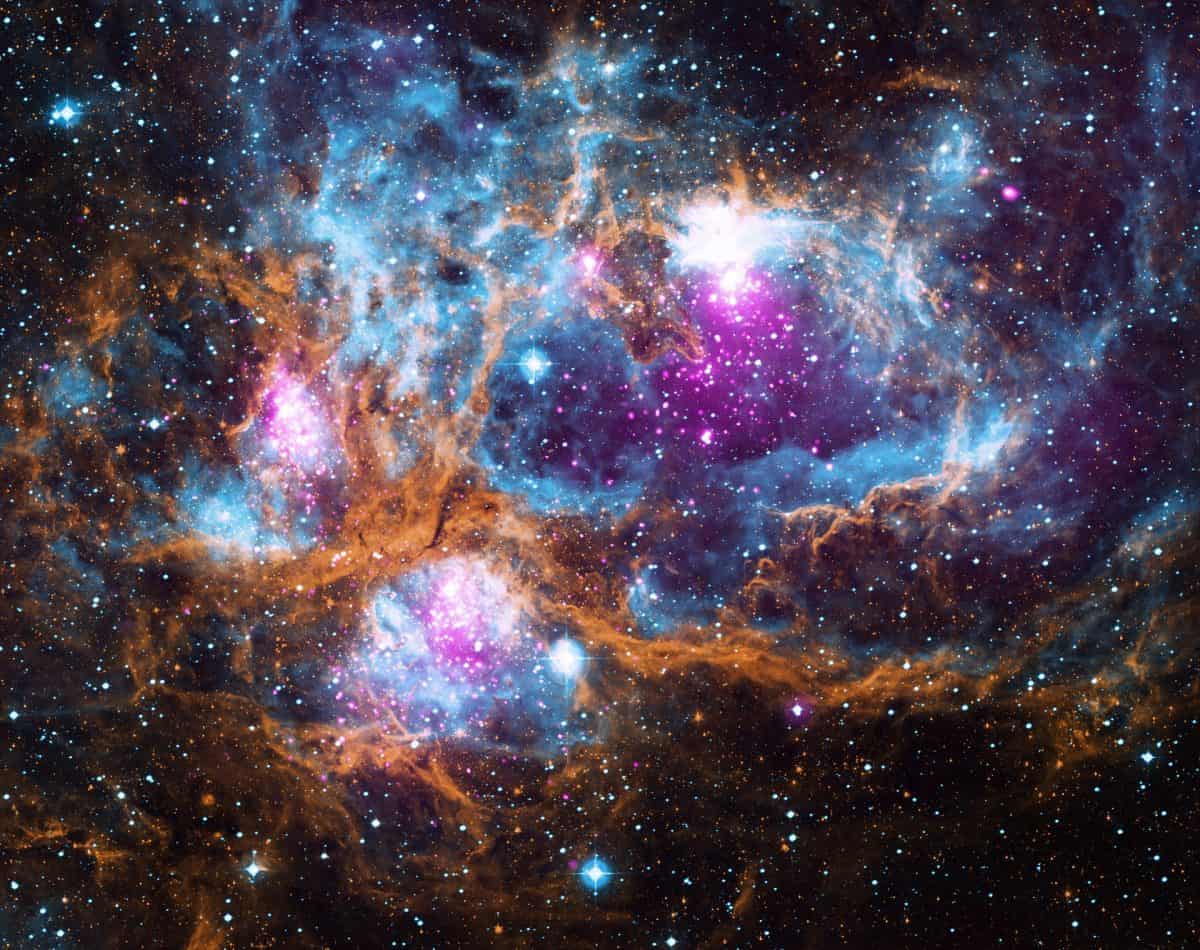Blog
Is there a bridge of gas connecting these two great galaxies? Quite possibly, but it is hard to be sure. M86 on the upper left is a giant elliptical galaxy near the center of the nearby Virgo Cluster of galaxies. Our Milky Way Galaxy is falling toward the Virgo Cluster, located about 50 million light years away. To the lower right of M86 is unusual spiral galaxy NGC 4438, which, together with angular neighbor NGC 4435, are known as the Eyes Galaxies (also Arp 120). Featured here is one of the deeper images yet taken of the region, indicating that red-glowing gas surrounds M86 and seemingly connects it to NGC 4438. The image spans about the size of the full moon. It is also known, however, that cirrus gas in our own Galaxy is superposed in front of the Virgo cluster, and observations of the low speed of this gas seem more consistent with this Milky Way origin hypothesis. A definitive answer may come from future research, which may also resolve how the extended blue arms of NGC 4435 were created.
more...David Van Cortlandt Crosby (born August 14, 1941) is an American singer-songwriter and guitarist. In addition to his solo career, he was a founding member of both the Byrds and Crosby, Stills & Nash.
Crosby joined The Byrds in 1964. The band notably gave Bob Dylan his first number one hit in April 1965 with “Mr. Tambourine Man.” Crosby ultimately appeared on the band’s first five albums, and produced the original lineup’s 1973 reunion album. In 1967 he joined Stephen Stills of Buffalo Springfield on stage at the Monterey Pop Festival, which contributed to his dismissal from the Byrds. He subsequently formed Crosby, Stills & Nash in 1968 with Stills and Graham Nash of The Hollies. After the release of their debut album CSN won the Grammy Award for Best New Artist of 1969. Neil Young joined the group for live appearances, their second concert being Woodstock, before recording their second album Déjà Vu. Meant to be a group that could collaborate freely, Crosby and Nash recorded 3 gold albums in the 1970s, while the core trio of CSN remained active from 1976 until 2016. CSNY reunions took place in each decade from the 1970s through the 2000s.
Songs Crosby wrote or co-wrote include “Lady Friend,” “Why,” and “Eight Miles High” with the Byrds and “Guinnevere,” “Wooden Ships,” “Shadow Captain,” and “In My Dreams” with Crosby, Stills & Nash. He wrote “Almost Cut My Hair” and the title track “Déjà Vu” for Crosby, Stills, Nash & Young‘s 1970 album. He is known for his use of alternate guitar tunings and jazz influences. He has released six solo albums, five of which have charted. Additionally he formed a jazz influenced trio with his son James Raymond in CPR. Crosby’s work with The Byrds and CSN(Y) has sold over 35 million albums.
https://www.youtube.com/watch?v=6usoXUL2ncw
more...Frank “Son” Seals (August 13, 1942 – December 20, 2004) was an American electric blues guitarist and singer.
Seals was born in Osceola, Arkansas, where his father, Jim “Son” Seals, owned a small juke joint. He began performing professionally by the age of 13, first as a drummer with Robert Nighthawk and later as a guitarist. At age 16, he began to play at the T-99, a local upper-echelon club, with his brother-in-law Walter “Little Walter” Jefferson. He played there with prominent blues musicians, including Albert King, Rufus Thomas, Bobby Bland, Junior Parker, and Rosco Gordon. Their varying styles contributed to the development of Seals’s own playing techniques. While playing at the T-99, he was also introduced to country–western music by Jimmy Grubbs, who occasionally asked Seals to play the drums or guitar with his group. At the age of 19, Seals formed his own band, Son Seals and the Upsetters, to fill in at the Rebel Club, in Osceola. The band members were Johnny Moore (“Old Man Horse”) on piano; Alvin Goodberry on drums, guitar, bass, or piano; Little Bob Robinson on vocals; and Walter Lee “Skinny Dynamo” Harris on piano. Shortly thereafter, a man from Little Rock, Arkansas, came to find “Little Walter” for a gig at his club, but when Walter turned it down the offer went to Seals.
more...Hezekiah Leroy Gordon Smith (August 14, 1909 – September 25, 1967), better known as Stuff Smith, was an American jazz violinist. He is well known for the song “If You’re a Viper” (the original title was “You’se a Viper”).
Smith was, along with Stéphane Grappelli, Michel Warlop, Svend Asmussen and Joe Venuti, one of jazz music’s preeminent violinists of the swing era. He was born in Portsmouth, Ohio, in 1909 and studied violin with his father. Smith cited Louis Armstrong as his primary influence and inspiration to play jazz, and like Armstrong, was a vocalist as well as instrumentalist. In the 1920s, he played in Texas as a member of Alphonse Trent‘s band. After moving to New York City he performed regularly with his sextet at the Onyx Club starting in 1935 and also with Coleman Hawkins, Charlie Parker, Dizzy Gillespie, and later, Sun Ra.
https://www.youtube.com/watch?v=AouyO2aID70
more...The 2018 lineup: Michalis Cholevas on yayli tanbur, tarhu, ney; Michalis Kouloumis on violin; Giannis Koutis on oud, guitar, voice; and Ruven Ruppik on riq, darbuka, frame drums, marimba.
more...This shock wave plows through interstellar space at over 500,000 kilometers per hour. Near the top and moving up in this sharply detailed color composite, thin, bright, braided filaments are actually long ripples in a cosmic sheet of glowing gas seen almost edge-on. Cataloged as NGC 2736, its elongated appearance suggests its popular name, the Pencil Nebula. The Pencil Nebula is about 5 light-years long and 800 light-years away, but represents only a small part of the Vela supernova remnant. The Vela remnant itself is around 100 light-years in diameter, the expanding debris cloud of a star that was seen to explode about 11,000 years ago. Initially, the shock wave was moving at millions of kilometers per hour but has slowed considerably, sweeping up surrounding interstellar material. In the featured narrow-band, wide field image, red and blue colors track the characteristic glow of ionized hydrogen and oxygen atoms, respectively.
more...Mulgrew Miller (August 13, 1955 – May 29, 2013) was an American jazz pianist, composer, and educator. As a child he played in churches and was influenced on piano by Ramsey Lewis and then Oscar Peterson. Aspects of their styles remained in his playing, but he added the greater harmonic freedom of McCoy Tyner and others in developing as a hard bop player and then in creating his own style, which influenced others from the 1980s on.
Miller’s style evolved through playing with a series of major jazz figures. After leaving university he was pianist with the Duke Ellington Orchestra for three years, then accompanied vocalist Betty Carter. Three-year stints with trumpeter Woody Shaw and with drummer Art Blakey‘s high-profile Jazz Messengers followed, by the end of which Miller had formed his own bands and begun recording under his own name. He was then part of drummer Tony Williams‘ quintet from its foundation, while continuing to play and record with numerous other leaders, mostly in small groups. Miller was Director of Jazz Studies at William Paterson University from 2005, and continued to play and tour internationally with other high-profile figures in the music until his death from a stroke at the age of 57.
Mulgrew Miller was born in Greenwood, Mississippi, to parents who had been raised on plantations. He had three brothers and four sisters. His family was not musical, but they had a piano, which no one in the house could play. Miller, however, played tunes on the piano from the age of six, playing by ear. He had piano lessons from the age of eight. As a child, he played bluesand rhythm and blues for dances, and gospel music in a church.His family was Methodist, but he played in churches of various denominations. His principal influence on piano at this stage was Ramsey Lewis.
more...Sir George Albert Shearing, OBE (13 August 1919 – 14 February 2011) was a British jazz pianist who for many years led a popular jazz group that recorded for Discovery Records, MGM Records and Capitol Records. The composer of over 300 titles, including the jazz standard “Lullaby of Birdland“, had multiple albums on the Billboard charts during the 1950s, 1960s, 1980s and 1990s. He died of heart failure in New York City, at the age of 91.
Born in Battersea, London, Shearing was the youngest of nine children. He was born blind to working class parents: his father delivered coal and his mother cleaned trains in the evening. He started to learn piano at the age of three and began formal training at Linden Lodge School for the Blind, where he spent four years.
more...Rotterdam-based band Tabanka plays lively music from Cape Verde. The band was inspired by artists from an earlier generation, such as Bulimundo and Américo Brito. Tabanka performs a contemporary version of funaná, a danceable and energetic music of the Cape Verdean island of Santiago. Funaná is the music of the descendants of slaves that was combined in the 1980s with pop and jazz. It became part of the Cape Verdean identity after independence. The foundation for Funaná is the diatonic accordion (gaita) and the ferrinho, a metal rod with notches which is grated.
more...https://www.youtube.com/watch?v=F1VOTKiPEOM
more...What’s that green streak in front of the Andromeda galaxy? A meteor. While photographing the Andromeda galaxy in 2016, near the peak of the Perseid Meteor Shower, a sand-sized rock from deep space crossed right in front of our Milky Way Galaxy‘s far-distant companion. The small meteor took only a fraction of a second to pass through this 10-degree field. The meteor flared several times while braking violently upon entering Earth’s atmosphere. The green color was created, at least in part, by the meteor’s gas glowing as it vaporized. Although the exposure was timed to catch a Perseids meteor, the orientation of the imaged streak seems a better match to a meteor from the Southern Delta Aquariids, a meteor shower that peaked a few weeks earlier. Not coincidentally, the Perseid Meteor Shower peaks again tonight.
more...Patrick Bruce Metheny (/məˈθiːni/ mə-THEE-nee; born August 12, 1954) is an American jazz guitarist and composer.
He is the leader of the Pat Metheny Group and is also involved in duets, solo works, and other side projects. His style incorporates elements of progressive and contemporary jazz, Latin jazz, and jazz fusion. Metheny has three gold albums and 20 Grammy Awards and is the only person to win Grammys in ten different categories. He is the brother of jazz flugelhornist Mike Metheny.
When Pat Metheny Group (ECM, 1978) was released, the Group was a quartet comprising, besides Metheny, Danny Gottlieb on drums, Mark Egan on bass, and Lyle Mays on piano, autoharp and synthesizer. All but Egan had played on Metheny’s album Watercolors (ECM, 1977), recorded a year before the first Group album.
The long list of his collaborators includes Lyle Mays, Bill Frisell, Billy Higgins, Brad Mehldau, Charlie Haden, Chick Corea, Dave Holland, Dewey Redman, Eberhard Weber, Herbie Hancock, Jack DeJohnette, Jaco Pastorius, John Scofield, Joni Mitchell, Joshua Redman, Marc Johnson, Michael Brecker, Mick Goodrick, Roy Haynes, Steve Swallow, and Tony Williams.
https://www.youtube.com/watch?v=v0DgOXYg3ZI
more...Jonathan David Samuel Jones (October 7, 1911 – September 3, 1985) was an American jazz drummer. A band leader and pioneer in jazz percussion, Jones anchored the Count Basie Orchestra rhythm section from 1934 to 1948. He was sometimes known as Papa Jo Jones to distinguish him from younger drummer Philly Joe Jones.
Born in Chicago, Illinois, Jones moved to Alabama, where he learned to play several instruments, including saxophone, piano, and drums. He worked as a drummer and tap-dancer at carnival shows until joining Walter Page‘s band, the Blue Devils in Oklahoma City in the late 1920s. He recorded with trumpeter Lloyd Hunter‘s Serenaders in 1931, and later joined pianist Count Basie‘s band in 1934. Jones, Basie, guitarist Freddie Green and bassist Walter Page were sometimes billed as an “All-American Rhythm section,” an ideal team. Jones took a brief break for two years when he was in the military, but he remained with Basie until 1948. He participated in the Jazz at the Philharmonic concert series.
He was one of the first drummers to promote the use of brushes on drums and shifting the role of timekeeping from the bass drum to the hi-hatcymbal. Jones had a major influence on later drummers such as Buddy Rich, Kenny Clarke, Roy Haynes, Max Roach, and Louie Bellson. He also starred in several films, most notably the musical short Jammin’ the Blues (1944).
more...Sami from Norway
more...https://www.youtube.com/watch?v=hh_IccWWRtY
more...Although there are no seasons in space, this cosmic vista invokes thoughts of a frosty winter landscape. It is, in fact, a region called NGC 6357 where radiation from hot, young stars is energizing the cooler gas in the cloud that surrounds them. This composite image contains X-ray data from NASA’s Chandra X-ray Observatory and the ROSAT telescope (purple), infrared data from NASA’s Spitzer Space Telescope (orange), and optical data from the SuperCosmos Sky Survey (blue) made by the United Kingdom Infrared Telescope. Located in our galaxy about 5,500 light years from Earth, NGC 6357 is actually a “cluster of clusters,” containing at least three clusters of young stars, including many hot, massive, luminous stars. The X-rays from Chandra and ROSAT reveal hundreds of point sources, which are the young stars in NGC 6357, as well as diffuse X-ray emission from hot gas. There are bubbles, or cavities, that have been created by radiation and material blowing away from the surfaces of massive stars, plus supernova explosions. Astronomers call NGC 6357 and other objects like it “HII” (pronounced “H-two”) regions. An HII region is created when the radiation from hot, young stars strips away the electrons from neutral hydrogen atoms in the surrounding gas to form clouds of ionized hydrogen, which is denoted scientifically as “HII”. Researchers use Chandra to study NGC 6357 and similar objects because young stars are bright in X-rays. Also, X-rays can penetrate the shrouds of gas and dust surrounding these infant stars, allowing astronomers to see details of star birth that would be otherwise missed.
more...Thetakudi Harihara Vinayakram (born 11 August 1942), also known as Vikku Vinayakram, is a Grammy Award–winning Indian percussionist. He plays Carnatic music with the ghatam, an earthen pot, and is credited with popularising the ghatam.
He was awarded the Padma Shri, given by Government of India in 2002, and later the 2012 Sangeet Natak Akademi Fellowship, the highest honour in the performing arts conferred by the Sangeet Natak Akademi, India’s National Academy for Music, Dance and Drama. Finally he was awarded the Padma Bhushan in 2014.
Vinayakram was born to Kalaimaamani T. R. Harihara Sharma, a musician and teacher. He took up playing at a very young age.
more...Eldridge Freeman (August 11, 1921 – 2006), also known as “Buzz” Freeman or “Bruz” Freeman, was an American jazz drummer.
Born in Chicago, with his brothers, guitarist George Freeman and tenor saxophonist Von Freeman, he played for several years in the house band at the Pershing Hotel. He was also the uncle of Chico Freeman, the son of Von Freeman.
In 1950, he was a member of John Young‘s trio with LeRoy Jackson on bass, and recorded with Young’s orchestra backing vocalist Lurlean Hunter.
In the mid-1950s, he was a member of the Hampton Hawes Quartet, with Red Mitchell and Jim Hall, and with line-ups led by Herb Geller. In 1950, with his brothers George and Von (originally misidentified as Claude McLin), LeRoy Jackson, and Chris Anderson, he played with Charlie Parker shortly before his death, at a jam session recorded at Bird’s apartment which was released in 1960 by Savoy.
more...More Posts
- The Cosmos with M63
- Cassandra Wilson
- Terry Woods
- Jim Hall
- Eddie Heywood
- Flamenco Fridays with Sabicas
- Daily Roots with Steel Pulse
- Surviving the Pandemic and Realizing Racial Justice
- The Cosmos with NGC 4038/39
- Joe Brother Cornbread Thomas
- Antonio Soler
- Kanaka Dasa
- World Fusion with Les Mamans du Congo & Rrobin
- Daily Roots with Scientist and Prince Jammy
- Surviving the Pandemic and Realizing Racial Justice
- The Cosmos with the Moon
- Tal Wilkenfeld
- Ronnie Mathews
- Wynton Kelly
- Charlie Ventura



